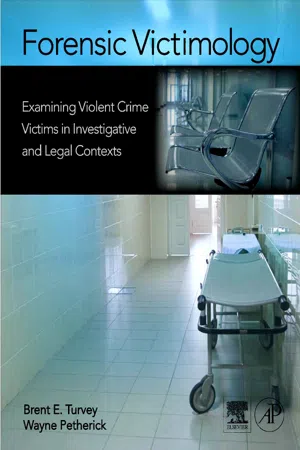
Forensic Victimology
Examining Violent Crime Victims in Investigative and Legal Contexts
- 608 pages
- English
- ePUB (mobile friendly)
- Available on iOS & Android
Forensic Victimology
Examining Violent Crime Victims in Investigative and Legal Contexts
About this book
This new textbook provides students with the basic principles and practice standards of forensic victimology--the scientific study of victims for the purposes of addressing investigative and forensic issues. It provides case-based coverage with original insights into the role that victimology plays in the justice system, moving beyond the traditional theoretical approaches already available. The purpose of this textbook is to distinguish the investigative and forensic aspects of victim study as a necessary adjunct to the field of victimology. It identifies forensic victimologists in the investigative and forensic communities and provides them with methods and standards of practice needed to be of service. This book is intended to educate students on the means and rationale for performing victimological assessments with a scientific mindset. Forensic Victimology is designed specifically for teaching the practical aspects of this topic, with "hands on real-life case examples.- Applied victimology for students and caseworkers performing objective examinations as opposed to theoretical victimology that studies victim groups and crime statistics.- First ever textbook detailing a mandate, scope and methods for forensic victimologist practitioners.- Provides a critical / scientific counterbalance to existing mainstream texts approaching general victimology with a pro-victim bias.- Written by practitioners of forensic victimology in the investigative, forensic, mental health, and academic communities.
Frequently asked questions
- Essential is ideal for learners and professionals who enjoy exploring a wide range of subjects. Access the Essential Library with 800,000+ trusted titles and best-sellers across business, personal growth, and the humanities. Includes unlimited reading time and Standard Read Aloud voice.
- Complete: Perfect for advanced learners and researchers needing full, unrestricted access. Unlock 1.4M+ books across hundreds of subjects, including academic and specialized titles. The Complete Plan also includes advanced features like Premium Read Aloud and Research Assistant.
Please note we cannot support devices running on iOS 13 and Android 7 or earlier. Learn more about using the app.
Information
Chapter 1. Victimology - A Brief History with an Introduction to Forensic Victimology
Contents
- History
- Key Figures
- Victim Study: Past to Present
- Forensic Victimology: An Introduction
- Case Example: Investigative Use of Forensic Victimology
- Summary
Key Terms
Criminal investigationthe process of gathering facts to be used as evidence and proof in a court of law.The Dark Agein victimology, the era after the emergence of written laws and structured governments, where all offenses were viewed as perpetrated against the king or state, not against the victims or their family.Forensic victimologythe study of violent crime victims for the purposes of addressing investigative and forensic questions. It involves the accurate, critical, and objective outlining of a victim's lifestyles and circumstances, the events leading up to an injury, and the precise nature of any harm or loss suffered.General victimologythe study of victimity in the broadest sense, including those that have been harmed by accidents, natural disasters, war, and so on.The golden agein victimology, the era thought to have occurred before written law, where victims played a direct role in determining the punishment for actions of another committed against them or their property.Interactionist/penal victimologyan approach to victimology from a criminological or legal perspective, where the scope of study is defined by criminal law.Reemergence of the victimthe era in the middle of the twentieth century, when a small number of people began to recognize that those who were most affected by criminal acts were rarely involved in the criminal justice process. This led to the realization that victims were also being overlooked as a source of information about crime and criminals.Sanctity of victimhoodthe belief that victims are inherently good, honest, and pure, making those who defend them righteous and morally justified.Scientific methoda way to investigate how or why something works or how something happened through the development of hypotheses and subsequent attempts at falsification through testing and other accepted means.Victimused in the modern criminal justice system to describe any person who has experienced loss, injury, or hardship due to the illegal action of another individual, group, or organization.Victimaa Latin word used to refer to those who were sacrificed to please a god.Victimologythe scientific study of victims and victimization, including the relationships between victims and offender, investigators, courts, corrections, media, and social movements.Victim precipitationwhen a crime is caused or partially facilitated by the victim.Victim proneindividuals who share a capacity for being victimized.
Figure 1.1. Dr. Fredric Wertham (1895–1981) reading the first issue of Shock Illustrated. A psychiatrist for the New York Department of Hospitals connected with the Court of General Sessions, he is best remembered for his expert testimony in the trial of serial murderer Albert Fish and for his opposition to comic books. In 1954, he wrote a book titled Seduction of the Innocents, which argued that comic books were the lowest form of literature and a primary cause of juvenile delinquency, citing their depiction of sex, drugs, and violence. That same year, this book led to an official Congressional Inquiry that ultimately resulted in the “voluntary” creation of the Comics Code Authority (CCA) by the Comics Magazine Association of America. The CCA screened all comic books prior to publication, acting essentially as an industry censor.

History
The Golden Age
Table of contents
- Cover
- Title
- Brief Table of Contents
- Table of Contents
- Acknowledgments
- Contributors
- Preface: An Argument for Forensic Victimology
- Chapter 1. Victimology
- Chapter 2. Victimity
- Chapter 3. Constructing a Victim Profile
- Chapter 4. Forensic Nursing
- BibliographyReferences
- Chapter 5. Victim Lifestyle Exposure
- Chapter 6. Victim Situational Exposure
- BibliographyReferences
- Chapter 7. Psychological Aspects of Victimology
- BibliographyReferences
- Chapter 8. False Allegations of Crime[1]
- Chapter 9. Intimate Violence
- Chapter 10. Victims of Stalking
- Chapter 11. Workplace Violence
- Chapter 12. School Shootings
- Chapter 13. Stranger Violence
- BibliographyReferences
- Chapter 14. Sexual Offenders and Their Victims
- BibliographyReferences
- Chapter 15. Victimology at Trial
- Chapter 16. Wrongful Convictions